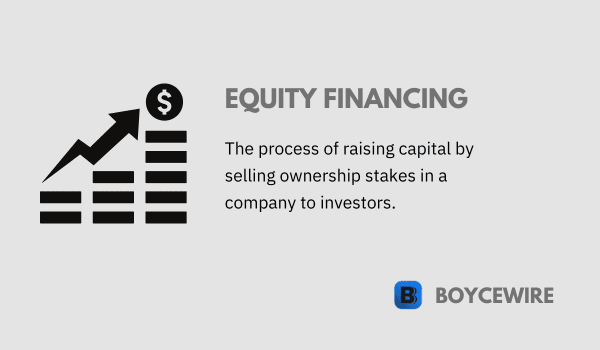Equity Financing: Definition, Pros, Cons & Examples

What is Equity Financing?
Equity financing, a key method for businesses to raise capital, provides an important lifeline for many organizations, particularly startups and growing companies that need funds for expansion. It is a form of financing where funds are raised by a company in exchange for a share of ownership in the business. This transaction can provide a win-win scenario – the company secures necessary capital without adding to its debt load, and investors acquire a stake in a potentially successful enterprise, with the prospect of gaining a return on their investment if the company flourishes.
The process of equity financing is not always straightforward, however. It involves several considerations, such as business valuation, investor relations, and legal regulations, among others. Moreover, while it comes with its own set of advantages, it also presents potential downsides, including the dilution of the original owners’ stakes.
Key Points
- Equity financing involves selling ownership shares of a company to investors in exchange for capital.
- Investors who participate in equity financing become partial owners of the business and share in its risks and rewards.
- Unlike debt financing, equity financing does not involve fixed interest payments or the obligation to repay a loan.
Understanding Equity Financing
Equity financing is a method of raising capital by selling shares of a company. These shares represent ownership interest in the company. In other words, the individuals or entities that buy these shares become co-owners of the company. This is different from debt financing, where funds are borrowed and need to be paid back with interest, but without the lender gaining ownership in the company.
Equity financing can come from various sources. It can be procured from private investors, also known as ‘angel investors’, venture capitalists, and the public through Initial Public Offerings (IPOs). For small businesses and startups, such financing can also come from friends, family, or even crowdfunding.
In each case, the investor provides capital to a company in exchange for shares, with the expectation that the company will be successful and provide a return on their investment. This return typically comes in the form of dividends (a share of the company’s profits) or capital gains (profit from selling the shares at a higher price).
The process often requires a company to disclose a significant amount of information to potential investors, including financial performance, operational details, and future plans. This process, especially when dealing with large amounts of capital, may also necessitate negotiations regarding the valuation of the company and the price of the shares.
The key to understanding equity financing is recognizing the trade-off it represents: while it provides companies with the necessary capital without the immediate burden of debt, it also involves giving up a portion of the ownership, and hence, a share in the future profits. Furthermore, as the number of shareholders increases, decision-making can become more complex due to the involvement of various stakeholders.
Types of Equity Financing
Equity financing is a method of raising capital by selling shares of a company. These shares represent ownership interest in the company. In other words, the individuals or entities that buy these shares become co-owners of the company. This is different from debt financing, where funds are borrowed and need to be paid back with interest, but without the lender gaining ownership in the company.
- Angel Investing This type of equity financing involves individual investors, known as angel investors, who provide capital for a business startup, usually in exchange for convertible debt or ownership equity. These investors often provide more favourable terms compared to other lenders, since they usually invest in the entrepreneur starting the business rather than the viability of the business itself.
- Venture Capital Venture capital (VC) is a type of private equity financing that is provided by venture capital firms or funds to startups, early-stage, and emerging companies that have been deemed to have high growth potential or which have demonstrated high growth. Unlike angel investors who usually make individual investments, venture capitalists pool resources from various investors to fund startups.
- Initial Public Offering (IPO) An IPO is the first sale of stock by a company to the public. Prior to an IPO, a company is classified as private, possessing a relatively limited number of shareholders, mainly comprising early investors and founders. Going public, or conducting an IPO, can be an effective way to raise a large amount of capital.
- Crowdfunding Crowdfunding is the use of small amounts of capital from a large number of individuals to finance a new business venture. This form of equity financing allows entrepreneurs to tap into the power of the internet to raise capital for their business.
- Private Placement This is a sale of stocks, bonds, or securities directly to a private investor, rather than as part of a public offering. This is typically a way for smaller companies to gain capital without needing to go through the complex and rigorous process of a larger-scale public offering.
Each type of equity financing has its own unique advantages and disadvantages, and a company’s specific situation and goals can help determine the most appropriate form of financing.
Process of Equity Financing
- Business Plan Development The first step in the equity financing process involves the creation of a detailed business plan. This plan will outline the business’s goals, strategies for achieving these goals, the target market, competitive analysis, and financial projections. It serves as the backbone for discussions with potential investors.
- Identifying Potential Investors Once the business plan is developed, the company will then identify potential investors. This could include venture capitalists, angel investors, private equity firms, or even friends and family. The company may also decide to raise funds from the public through a process known as an initial public offering (IPO).
- Pitching to Investors After identifying potential investors, the company then pitches its business plan to them. This typically involves meetings and presentations where the company explains why it is a good investment opportunity. The goal is to convince investors that they will receive a good return on their investment.
- Negotiation and Investment Terms If investors show interest, the company will then negotiate the terms of the investment. This involves determining how much equity in the company the investor will receive in exchange for their investment. Both parties will need to agree on a valuation of the company. Once the terms are agreed upon, the legal documents are drawn up.
- Funds Exchange and Ownership Shift After the agreement, the investor provides the agreed-upon funds and in return, receives equity, or shares, in the company. The company can use this cash influx for a variety of purposes such as expanding into new markets, investing in research and development, or scaling manufacturing capabilities.
- Ongoing Investor Relations After equity financing, investors often become partners in the business, in that they have a stake in the company’s future. Maintaining clear communication with these investors about the company’s performance is vital, as they are now partial owners.
- Exit Strategy Finally, every investor will be interested in the company’s proposed exit strategy. This could be in the form of an acquisition by another company, or the company going public, allowing the investors to sell their shares.
This process requires significant time and effort, but it can provide a business with the capital it needs to grow, and also offers investors the potential for significant returns.
Advantages of Equity Financing
- No Repayment Obligation Unlike loans, equity financing doesn’t need to be repaid, which can be particularly beneficial for startups that may not generate revenue immediately.
- Access to Additional Resources Investors often provide more than just funding. They can also offer strategic advice, industry connections, and other resources that can help the business grow.
- Shared Risk With equity financing, the financial risk of the business is shared with the investors. If the business does not succeed, investors share in the losses.
- Improved Cash Flow Since there’s no obligation to make monthly loan repayments, equity financing can improve a company’s cash flow – a key aspect of financial health, particularly for startups.
- Greater Capital Potential Equity financing can potentially raise more money than debt financing, especially if the company is high-growth or in a popular industry. This is because investors may be willing to invest large sums in hopes of a substantial return on investment.
- Long-term Planning Since investors are interested in long-term returns, businesses can focus on long-term growth strategies instead of short-term profitability.
While equity financing offers several advantages, it’s essential for businesses to carefully consider the implications of selling ownership stakes, as it might affect control over business decisions and future profits.
Disadvantages of Equity Financing
- Loss of Ownership and Control One of the significant disadvantages of equity financing is the potential loss of control. By selling shares of your company to raise funds, you’re also giving up a portion of your ownership, which can lead to reduced control over business decisions, especially if a significant percentage of the company is sold.
- Profit Sharing Equity investors buy into the company expecting a return on their investment. This usually means that they are entitled to a portion of the company’s profits, which can decrease the owner’s potential earnings.
- Investor Expectations Equity investors usually seek companies that offer significant growth potential. If your company does not deliver the expected results, it could lead to investor dissatisfaction and strained relationships.
- Difficulty in Finding Investors Finding suitable investors can be a challenging and time-consuming process. It often involves rigorous networking, pitching, and negotiations.
- Longer Process Compared to debt financing, equity financing usually takes longer as it involves more parties, negotiations, and legal processes.
- Lack of Privacy Companies that use equity financing are often required to disclose more information to investors, including financial statements and business strategies, leading to less privacy.
- Potential Conflicts Different shareholders may have different visions for the business, leading to potential conflicts.
Each company should weigh these disadvantages against the potential benefits when considering equity financing as a funding option.
Equity Financing in Different Stages of Business
Equity financing plays a unique role at different stages of a business’ lifecycle. Here is how it typically applies across various stages:
- Seed Stage At this stage, the business is still just an idea. Equity financing typically comes from the entrepreneur, friends, and family, or perhaps an angel investor willing to take a significant risk. These early-stage investors provide funds in exchange for ownership stakes, knowing the risk is high, and the return may be far in the future.
- Startup Stage Once a company has a defined business plan and a prototype product or beta service, it may seek equity financing from angel investors or venture capital firms. At this stage, such financing is often vital to hire staff, finalize a product or service, and bring it to market.
- Growth Stage (Early and Late) As businesses establish themselves with steady revenue streams, they often need additional equity financing to achieve new growth levels. This funding often comes from venture capitalists and private equity firms and may be used to invest in new technology, acquire competitors, or expand geographically.
- Maturity Stage Mature businesses that are profitable may still seek equity financing to fund major expansions or acquisitions. These companies often go public, conducting an initial public offering (IPO) that sells shares to public investors. After the IPO, the company’s stock can be bought and sold on public stock exchanges, providing an ongoing source of financing.
- Decline Stage Companies in this stage are struggling, and may turn to equity financing to provide the capital needed for a turnaround. However, it’s often more difficult to secure such financing at this stage because investors are wary of the risk.
It’s important to note that the sources of equity financing can overlap across different stages, and the specific circumstances of the business can greatly affect where it falls in this general lifecycle.
Examples of Equity Financing
- Startup Tech Company A tech startup looking to launch its product may approach venture capital firms to secure equity financing. In return for funding, the venture capital firm gets a stake in the company, hoping to earn a substantial return if the startup becomes successful. For instance, Facebook’s early stages were supported by equity investments from Accel Partners and Peter Thiel.
- Initial Public Offering (IPO) When a company reaches a certain stage of growth, it might decide to go public through an IPO. This allows it to raise substantial funds by selling shares to the general public. An example is Uber’s highly publicized IPO in 2019, which raised $8.1 billion, valuing the company at $82.4 billion.
- Equity Crowdfunding This is a newer form of equity financing where startups or small businesses raise funds from a large number of individuals, typically via online platforms. For example, BrewDog, a UK-based craft beer company, raised £7 million from over 40,000 investors through its “Equity for Punks” crowdfunding campaign.
- Angel Investing This involves affluent individuals investing their personal funds in a startup in exchange for equity. For example, Jeff Bezos was one of the first investors in Google, providing $250,000 in funding in 1998.
- Family and Friends Many entrepreneurs start with what’s known as “friends, family and fools” round of financing, where they raise capital from personal connections in exchange for equity in their company. For instance, when Bill Gates and Paul Allen started Microsoft, they secured early funding from Gates’ family members.
It’s important to note that all forms of equity financing come with their own set of challenges and benefits. Therefore, businesses must carefully consider their options and make choices that align with their long-term strategy and goals.
FAQs
Equity financing is a method of raising capital for a business by selling ownership shares to investors in exchange for funds.
In equity financing, the business sells shares of ownership to investors, whereas in debt financing, the business borrows funds and promises to repay the principal amount with interest.
Equity financing does not involve debt repayment, and investors share the risks and rewards of the business. Additionally, it can provide access to expertise and networks of the investors.
By selling ownership shares, the business gives up partial ownership and decision-making control. Moreover, future profits are shared with investors.
About Paul
Paul Boyce is an economics editor with over 10 years experience in the industry. Currently working as a consultant within the financial services sector, Paul is the CEO and chief editor of BoyceWire. He has written publications for FEE, the Mises Institute, and many others.

Further Reading
 Consumer Surplus: Graph, Examples & How to Calculate - The consumer surplus is the difference between what the consumer is willing to pay, and what they actually pay.
Consumer Surplus: Graph, Examples & How to Calculate - The consumer surplus is the difference between what the consumer is willing to pay, and what they actually pay.  Competitive Advantage: Definition, Types & Examples - A competitive advantage is where one business has an edge over anothers. In other words, it is what makes the…
Competitive Advantage: Definition, Types & Examples - A competitive advantage is where one business has an edge over anothers. In other words, it is what makes the…  Excise Tax: Definition, How it Works & Examples - An excise tax is a tax that is levied on specific products, usually in order to create a socially optimal…
Excise Tax: Definition, How it Works & Examples - An excise tax is a tax that is levied on specific products, usually in order to create a socially optimal… 